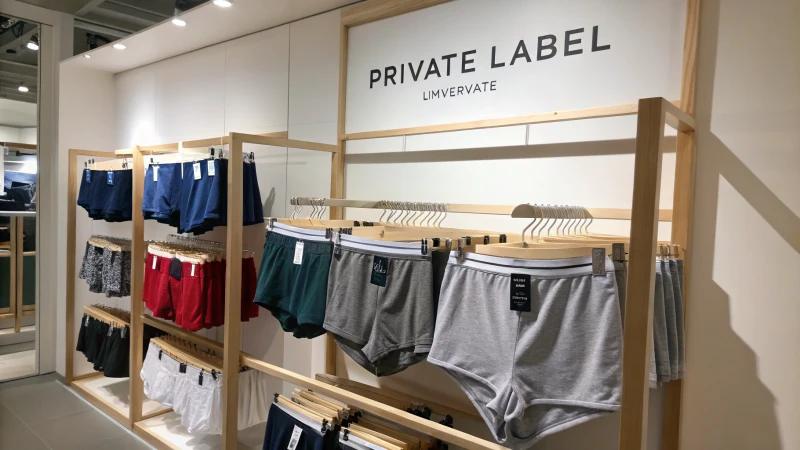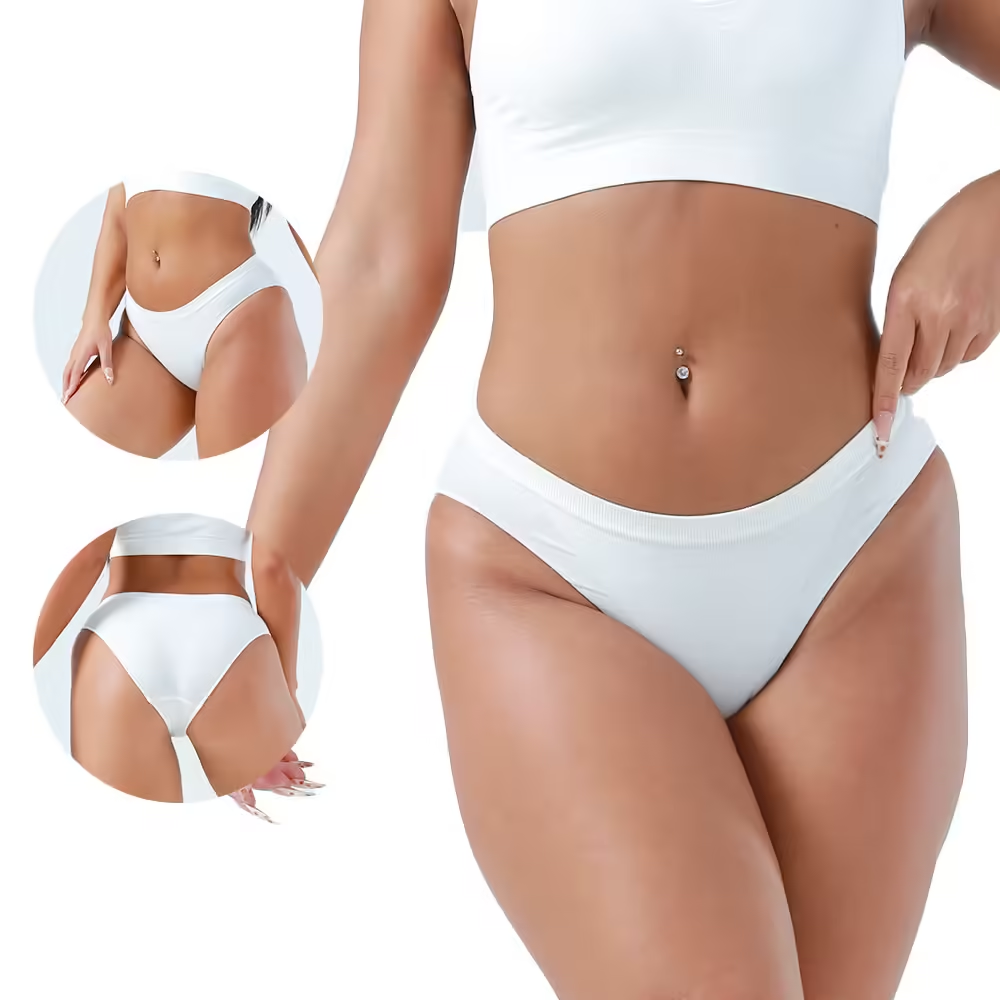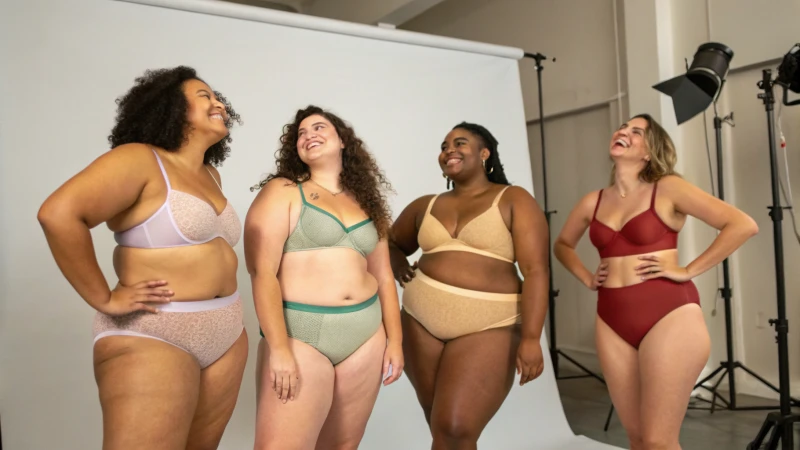
Have you ever thought about how the right underwear might affect your day? I dive into the exciting world of private label underwear for 2025. A rush of potential waits to be unlocked. This trend could very well change the game for aspiring entrepreneurs like you and me.
Ordering private label underwear in 2025 provides great benefits. Businesses gain brand control and enjoy higher profit margins. Custom designs are possible, allowing for unique styles. Competition is less intense, giving an edge. These advantages build a unique identity. Businesses foster customer loyalty in the crowded market. Loyalty really matters.
When I first thought about private labeling, I felt overwhelmed by the many possibilities. It involves creating a brand that truly connects with people. Imagine having total control over your brand's identity. This control helps your brand stand out in a crowded market. Higher profit margins and many customization options excited me. Private label underwear allows unique design tailored to customers’ preferences. It builds loyalty in a personal and rewarding way.
This blog will share insights on how private label underwear transforms a business strategy. It will discuss essential steps to launch your own line successfully. Get ready to discover the magic behind this very profitable venture!
Private label underwear offers higher profit margins than branded options.True
Businesses can achieve greater profitability by selling private label underwear due to lower production costs and direct brand control.
Ordering private label underwear guarantees reduced competition in 2025.False
While private label products can have less competition, the market may still be crowded, making this claim misleading.
How Does Brand Control Shape Your Business Success?
As an entrepreneur, I understand that brand control affects business success. This understanding is not just important. It is essential. Let me explain why brand management has deeply impacted my journey.
Brand control plays a huge role in business success. It really builds credibility. It also helps in creating customer loyalty. With brand control, companies stand out from competitors. Good branding management results in higher profit margins. Businesses adapt more easily in changing markets. This adaptability really matters.

The Importance of Brand Control
At first, I overlooked how crucial brand control was. I thought it was just industry jargon that only marketing people cared about. But soon, I realized that brand control is very important for a successful business. It guides how customers see your brand. This involves aligning all messages with your company's values and goals.
By maintaining brand control, businesses can:
- Build Credibility: Consistent branding builds trust with consumers. Even a small logo or the same color scheme can inspire confidence.
- Cultivate Loyalty: A known brand brings repeat purchases. When customers see familiar branding, they often feel a very strong sense of belonging.
- Stand Out from Competitors: Unique branding helps us shine in crowded markets. I recall a time when a competitor launched a similar product - our clear and distinct branding retained our customer base.
Here's a story: During a tough product launch, I relied heavily on our cohesive branding. Our consistent image proved effective. It made people recognize us immediately and really connected with them. This connection increased customer loyalty and led to success.
Brand Control and Customer Perception
Brand control goes beyond looks; it greatly affects how customers view our business. By managing our branding, we share our mission, values, and what makes us unique.
| Branding Element | Impact on Customer Perception |
|---|---|
| Visual Identity | Creates immediate recognition |
| Messaging | Conveys brand values clearly |
| Customer Experience | Enhances satisfaction and loyalty |
Carefully managing these aspects has positively shaped customer perceptions, leading to increased trust in my brand.
Financial Benefits of Brand Control
The financial rewards of brand control have been surprising. Companies investing in branding enjoy higher profit margins because of loyalty and premium pricing potential.
- Higher Profit Margins: A well-managed brand can ask for higher prices; I’ve seen people willing to pay more for products they trust.
- Reduced Marketing Costs: A strong brand cuts the need for heavy marketing since happy customers often become brand ambassadors.
To illustrate:
| Brand Strength | Impact on Profits |
|---|---|
| Strong | Higher average order value |
| Moderate | Competitive pricing necessary |
| Weak | Low sales volume |
The Role of Consistency in Branding
Consistency across all platforms strengthens brand recognition and builds loyal customers by delivering the same message everywhere.
- Clear Messaging: This prevents confusion and builds trust; it's rewarding to see customers recognize our messages across different platforms.
- Unified Visuals: A consistent look makes branding recognizable in many forms.
Look at Apple; their steady branding ensures loyal customers by keeping everything uniform from product design to customer experience. I strive to do the same in my business.
Navigating Market Changes Through Brand Control
In today's fast-changing market, brand control keeps my business adaptive without losing identity. This flexibility lets me follow trends or consumer feedback while staying true to values.
- Flexible Branding: I change strategies as needed but keep our brand true to itself.
- Crisis Management: A strong brand helps control the story during tough times.
This adaptability is crucial; it keeps my business going strong even during market changes.
For more on how brand control boosts business success, check out our articles on branding strategies1 and consumer loyalty2.
Brand control enhances customer loyalty and trust.True
Effective brand control fosters customer loyalty by creating a trustworthy image, leading to repeat purchases and long-term relationships with consumers.
Inconsistent branding reduces market competitiveness.True
When branding is inconsistent, it confuses customers and weakens the brand's presence, making it harder to compete in the market.
How Can You Customize Your Private Label Underwear for Maximum Impact?
Have you ever wondered how small details create a big impact on your private label underwear brand? Let's explore the fascinating world of customization options. These choices probably help your brand shine!
Private label underwear offers many customization options! You have a choice of different fabrics. Fabrics like cotton or bamboo are available. Styles vary between boxers, briefs and more. Branding elements include labels and packaging. You can adjust sizes for a better fit. Eco-friendly practices are also possible. Tailoring these details helps your brand be unique. It really connects with what consumers want.

Understanding Customization Options for Private Label Underwear
At the beginning of my underwear business, I felt amazed by the variety of customization options for private label underwear. I quickly understood how crucial it was for brands like mine to build a unique identity in a crowded market. It felt like discovering a treasure chest packed with opportunities!
Fabric Choices
Choosing the right fabric is one of the first and most thrilling customization options. Every material has a distinct personality. Finding the one that matches your brand vision is essential. Here are some of my top fabric preferences:
| Fabric Type | Characteristics |
|---|---|
| Cotton | Breathable and soft, perfect for everyday wear |
| Modal | Eco-friendly and silky, providing excellent comfort |
| Bamboo | Naturally antibacterial and highly breathable |
| Polyester | Durable and moisture-wicking, ideal for sportswear |
| Nylon | Lightweight and elastic, offering good stretch |
When I first felt bamboo fabric, it seemed like covering myself in a cloud! Sustainable brands picking materials like organic cotton or bamboo might really connect with consumers who care about the Earth.
Style Variations
Customization goes beyond fabric, extending to style variations. This part is where the fun begins! Brands can pick from:
- Boxers
- Briefs
- Trunks
- Thongs
- Bikini styles
I once launched a line aimed at younger audiences, focusing on lively trunk designs with cheerful patterns. Seeing the delight on customers' faces when they received their orders was invaluable! Every style provides different fits, attracting varied consumer tastes. Think about your audience and which styles will maybe make them smile.
Branding Options
Brand identity is vital in the private label market. Your creativity finds expression here. Underwear customization involves:
- Labeling: Creating unique brand labels that mirror your ethos.
- Packaging: Designing special packaging that enhances the unboxing experience.
- Tagging: Adding custom tags with logos or messages that foster a connection.
- Colors and Patterns: Customizing colors and prints tailored to your target group.
I've witnessed how effective branding can stand out on store shelves. It isn't only about being noticed; it's about being remembered! Explore ways to build loyalty and recognition among customers.
Size and Fit Customization
Providing varied sizes and fits is vital to accommodate all body types. Consider:
- Size Ranges: Offering a broad range ensures everyone feels represented.
- Fit Types: Options for relaxed, snug or tailored fits based on style choices.
- Custom Measurements: Letting customers provide specific measurements for a custom fit.
This level of customization not only elevates customer satisfaction but reduces return rates due to sizing issues. A very happy customer becomes a loyal customer!
Eco-Friendly Customization Options
I have become increasingly aware of sustainability and many brands are exploring eco-friendly options. You might consider:
- Selecting fabrics made from recycled materials.
- Adopting sustainable production methods that cut waste.
- Utilizing eco-friendly dyes that minimize environmental harm.
These steps can draw environmentally conscious customers, expanding your market reach. If you're curious about these practices, consider exploring sustainable manufacturing sustainable manufacturing.
Conclusion
vVarious customization options for private label underwear empower brands like mine to create products that truly reflect our values while meeting customer needs. Every detail matters in establishing a strong market presence. The journey of customizing underwear has been not only a business endeavor but also a personal passion.
Private label underwear allows for eco-friendly fabric options.True
Brands can choose sustainable materials like bamboo and organic cotton for eco-friendly underwear customization.
Customization includes unique packaging designs for private label underwear.True
Distinctive packaging enhances brand identity and improves customer experience in private label underwear.
How Does Private Labeling Foster Customer Loyalty?
Have you ever thought about how private labeling builds strong ties between brands and customers? Let's explore this strategy deeply. We will reveal the emotional bonds that bring customers back repeatedly. These connections are very powerful.
Private labeling grows customer loyalty by forming unique brand identities that connect emotionally. High-quality control builds trust. Tailored products give personalization a special touch. Exclusivity keeps demand high. Perceived value maybe reduces price sensitivity. Long-term relationships form with suppliers.

Unique Brand Identity
Private labeling stands like a distinct recipe in a busy kitchen. Businesses craft their own unique identity and stand apart from others. I remember a local brand that created exclusive designs matching my style. It felt like they made those products specifically for me. This bond builds loyalty. Customers start to link their own identity with the brand. They truly feel connected.
When a brand shares its story - like a dream for something new - it invites customers into its world. Brands that stress their uniqueness form stronger emotional bonds with buyers. These buyers choose their products over ordinary options.
Higher Quality Control
Picture entering a store and finding a product you trust. Private labeling often grants companies tighter control over quality. Quality brings satisfaction. I recall buying from a luxury brand and feeling proud. It was created with care and attention.
Consider the following table illustrating this relationship:
| Control Level | Customer Loyalty Impact | Example |
|---|---|---|
| High | High | Luxury fashion brands |
| Moderate | Moderate | Mid-tier retailers |
| Low | Low | Generic brands |
When customers know they can rely on a brand for high quality, they become more loyal.
Tailored Products and Customization
We all appreciate products made just for us. Private label products allow brands to meet individual preferences, like sizes and designs. Once, I designed shoes by choosing colors and materials that expressed "me." This personalization formed an emotional link, making me a repeat buyer.
Brands offering customizable options, like personal choices in clothing, meet the desire for ownership and deepen loyalty.
Exclusivity Creates Demand
There's joy in owning something special. Private labeling often results in exclusive offers that customers crave. When I encountered a brand that produced only limited items, I felt a strong need to get my piece before it was gone.
This exclusivity drives demand and encourages customers to return for unique items that mirror their individuality. Brands that successfully leverage exclusivity often see repeat purchases, as customers want to maintain access to these unique offerings. Learn more about exclusivity in marketing3.
Reduced Price Sensitivity
Private label products attract me as they present great value without losing quality. The feeling of getting more for less is very appealing.
I remember switching from a big brand to a private label. The quality was equal or better and it was liberating to save some money.
When consumers sense value, they naturally become more loyal.
Building Long-Term Relationships
The hidden relationships between brands and manufacturers affect customer loyalty. When companies build strong connections with their suppliers, they achieve better terms and consistent product quality.
I've seen brands focusing on these relationships delivering products consumers trust repeatedly.
Relationships matter.
In summary, private labeling goes beyond a business strategy. It builds emotional ties with customers through unique identities, quality control, tailored products, exclusivity, perceived value and strong supplier relationships.
Private labeling creates unique brand identities for businesses.True
Unique brand identities foster emotional connections with consumers, enhancing loyalty and preference for private label products over generic options.
Higher quality control leads to increased customer satisfaction.True
Brands with private labeling can ensure consistent quality, which boosts customer satisfaction and loyalty as consumers rely on them for dependable products.
What Strategies Can You Implement for a Successful Launch?
Planning to introduce a new product? It's both exciting and stressful! I know how it feels. Everything depends on careful planning. Let's explore some strategies that truly help you succeed in your launch.
A successful product launch requires a clear understanding of your target audience. Identify who they are. Define a unique selling proposition (USP) to show why your product stands out. Set realistic goals by using SMART criteria. Use multiple marketing channels to reach more people. Gather early feedback from potential customers to learn what they think. Plan an exciting launch event. Monitor performance continuously after the launch. This monitoring is really important.

Know Your Audience
Understanding the audience is crucial. I realized this while launching my product. Conducting thorough market research felt tiring, but it taught me a lot! Utilize surveys and focus groups to gather insights about your audience’s expectations. This will help you tailor your product features and marketing messages effectively. I created customer personas to picture my audience and their needs. Surprisingly, one survey revealed that 70% of my audience cared about sustainability. This information really influenced my product and marketing plan!
Define Your Special Feature
Discovering the unique feature of my product was like finding a secret recipe ingredient. It differentiates it in a busy market. A clear Unique Selling Proposition (USP) sets your product apart from competitors. I asked myself: What sets my product apart? With my men's underwear line, it was the eco-friendly materials and stylish design that catered to a modern audience. Looking at competitors helped too; this was key in spotting market gaps.
| Competitor | USP | Gaps in Market |
|---|---|---|
| Brand A | Affordable luxury | Sustainable options |
| Brand B | Innovative design | Comfort-focused products |
Set Clear and Achievable Goals
Setting goals initially seemed daunting. Establishing clear goals is crucial for measuring your launch success. Using SMART criteria made it simpler:
- Specific: Get 5,000 pre-orders in the first month.
- Measurable: Track website traffic and conversion rates.
- Achievable: Use past launches for realistic expectations.
- Relevant: Make sure goals match business growth.
- Time-bound: Review after three months.
Use Various Marketing Methods
Relying on one marketing method is not effective; I used many! Leverage multiple marketing channels to reach your audience effectively:
- Social Media: Social media was my loudspeaker, engaging potential customers through posts and ads on platforms like Instagram and Facebook.
- Email Marketing: Email connected me personally to my audience; consider creating an email list for newsletters and launch announcements using tools like Mailchimp4.
- Influencer Partnerships: Partnering with like-minded influencers boosted visibility; collaborate with influencers who resonate with your target market to increase visibility.
- Content Marketing: Content marketing educated customers about my products; provide valuable content related to your product that educates and informs your audience about its benefits using tools like Hootsuite for social media management.
Collect Feedback Early
Before the official launch, I asked potential customers for feedback on prototypes through focus groups or surveys. Engaging potential customers before the official launch helps refine the product:
Questions like “What features do you value most?” led to major improvements based on their suggestions, ensuring it meets customer expectations.
Plan a Fun Launch Event
The launch event was thrilling! An effective launch event can create buzz around your product, whether online or offline:
Elements to include in your launch event:
- Product demonstrations or trials;
- Q&A sessions with the team;
- Special promotions or discounts for attendees;
- Live social media coverage to reach a broader audience.
The energy of that day still inspires my work!
Watch Performance After Launch
After the launch, I focused on data by continuously monitoring performance against earlier goals set using analytics tools to track sales data, customer feedback, and engagement metrics across all channels. When sales dropped below expectations, I revisited marketing tactics and tackled any new customer concerns that arose.
Understanding your target audience is crucial for a successful launch.True
Market research helps tailor products to customer needs, increasing the chances of success.
Setting unrealistic goals can hinder product launch success.True
SMART goals ensure objectives are achievable and relevant, leading to better outcomes.
Conclusion
Ordering private label underwear in 2025 provides entrepreneurs with brand control, higher profits, customization options, reduced competition, and enhanced customer loyalty through unique product offerings.
Learn about strategies for maintaining consistent branding across various platforms. ↩
Discover ways to adapt your branding strategy in response to market changes. ↩
Explore how private labeling strategies can enhance customer loyalty for brands by clicking this link. ↩
Discover expert insights on effective product launch strategies that can help enhance your planning process. ↩






